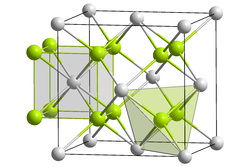Curium (IV) oxide
| Crystal structure | |||||||||||||
|---|---|---|---|---|---|---|---|---|---|---|---|---|---|

|
|||||||||||||
| __ Cm 4+ __ O 2− | |||||||||||||
| Crystal system | |||||||||||||
| Space group |
Fm 3 m (No. 225) |
||||||||||||
| Lattice parameters |
a = 536 pm |
||||||||||||
| Coordination numbers |
Cm [8], O [4] |
||||||||||||
| General | |||||||||||||
| Surname | Curium (IV) oxide | ||||||||||||
| other names |
Curium dioxide |
||||||||||||
| Ratio formula | CmO 2 | ||||||||||||
| Brief description |
black solid |
||||||||||||
| External identifiers / databases | |||||||||||||
|
|||||||||||||
| properties | |||||||||||||
| Molar mass | depending on the isotope: 270–284 g · mol −1 | ||||||||||||
| Physical state |
firmly |
||||||||||||
| Melting point |
380 ° C (decomposition) |
||||||||||||
| Hazard and safety information | |||||||||||||
 Radioactive |
|||||||||||||
|
|||||||||||||
| Thermodynamic properties | |||||||||||||
| ΔH f 0 |
167 ± 5 J (mol K) −1 |
||||||||||||
| As far as possible and customary, SI units are used. Unless otherwise noted, the data given apply to standard conditions . | |||||||||||||
Curium (IV) oxide (also curium dioxide ) is a chemical compound of the elements curium and oxygen . It has the empirical formula CmO 2 . Since all isotopes of curium are only artificially produced, it has no natural occurrence. It is produced implicitly in nuclear reactors when uranium dioxide (UO 2 ) or plutonium dioxide (PuO 2 ) are irradiated with neutrons.
presentation
Curium (IV) oxide can be prepared directly from the elements. For this purpose, metallic curium is annealed in air or in an oxygen atmosphere.
The glowing of Curium salts is ideal for small quantities . Mostly curium (III) oxalate (Cm 2 (C 2 O 4 ) 3 ) or curium (III) nitrate (Cm (NO 3 ) 3 ) are used.
Another possibility is the conversion of curium (III) oxide (Cm 2 O 3 ) in an oxygen atmosphere at 650 ° C.
properties
Physical Properties
Curium (IV) oxide is a black solid. It crystallizes in the cubic crystal system in the fluorite structure in the space group Fm 3 m (space group no. 225) and the coordination numbers are Cm [8], O [4]. The lattice parameter is 536 pm . The enthalpy of formation at 25 ° C is estimated to be 167 ± 5 J / (mol · K).
Chemical properties
The compound begins to decompose from around 380 ° C. In this process, a compound with the empirical formula CmO 1.95 is formed with the release of oxygen , from which curium (III) oxide is formed from 430 ° C under reduction . In an oxygen atmosphere, however, curium dioxide is stable even at higher temperatures (see also illustration ).
safety instructions
Classifications according to the CLP regulation are not available because they only include chemical hazard and play a completely subordinate role compared to the hazards based on radioactivity . The latter also only applies if the amount of substance involved is relevant.
Individual evidence
- ↑ Gregg J. Lumetta, Major C. Thompson, Robert A. Penneman, P. Gary Eller: Curium , in: Lester R. Morss, Norman M. Edelstein, Jean Fuger (ed.): The Chemistry of the actinides and transactinide element element , Springer, Dordrecht 2006; ISBN 1-4020-3555-1 , pp. 1397-1443 ( doi : 10.1007 / 1-4020-3598-5_9 ).
- ^ A b W. C. Mosley: Phases and Transformations in the Curium-Oxygen System , in: J. Inorg. Nucl. Chem. , 1972 , 34 (2), pp. 539-555 ( doi : 10.1016 / 0022-1902 (72) 80434-2 ).
- ↑ The hazards emanating from radioactivity do not belong to the properties to be classified according to the GHS labeling. With regard to other hazards, this substance has either not yet been classified or a reliable and citable source has not yet been found.
- ↑ a b R. JM Konings: Thermochemical and Thermophysical Properties of Curium and its Oxides , in: J. Nucl. Mater. , 2001 , 298 (3), pp. 255-268 ( doi : 10.1016 / S0022-3115 (01) 00652-3 ).
- ^ LB Asprey, FH Ellinger, S. Fried, WH Zachariasen: Evidence for Quadrivalent Curium: X-Ray Data on Curium Oxides , in: J. Am. Chem. Soc. , 1955 , 77 (6), pp. 1707-1708 ( doi : 10.1021 / ja01611a108 ).
- ↑ M. Noé, J. Fuger: Self-radiation effects on the lattice parameter of 244 CmO 2 , in: Inorg. Nucl. Chem. Lett. , 1971 , 7 (5), pp. 421-430 ( doi : 10.1016 / 0020-1650 (71) 80177-0 ).
- ^ JC Wallmann: A Structural Transformation of Curium Sesquioxide , in: J. Inorg. Nucl. Chem. , 1964 , 26 (12), pp. 2053-2057 ( doi : 10.1016 / 0022-1902 (64) 80149-4 ).
literature
- Gregg J. Lumetta, Major C. Thompson, Robert A. Penneman, P. Gary Eller: Curium , in: Lester R. Morss, Norman M. Edelstein, Jean Fuger (Eds.): The Chemistry of the Actinide and Transactinide Elements , Springer, Dordrecht 2006; ISBN 1-4020-3555-1 , pp. 1397-1443 ( doi : 10.1007 / 1-4020-3598-5_9 ).
![{\ displaystyle {\ ce {Cm + O2 -> [\ Delta T] CmO2}}}](https://wikimedia.org/api/rest_v1/media/math/render/svg/d46ff3d0ced7dfbbc28d3abd37b5362af12d0782)
![{\ displaystyle {\ ce {2 Cm2O3 + O2 -> [\ Delta T] 4 CmO2}}}](https://wikimedia.org/api/rest_v1/media/math/render/svg/d3ad302409428ad21aff1d0b37d5564a4ab617d9)